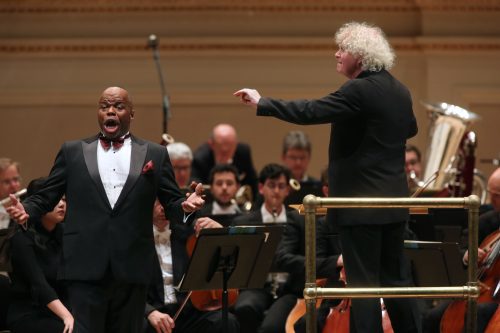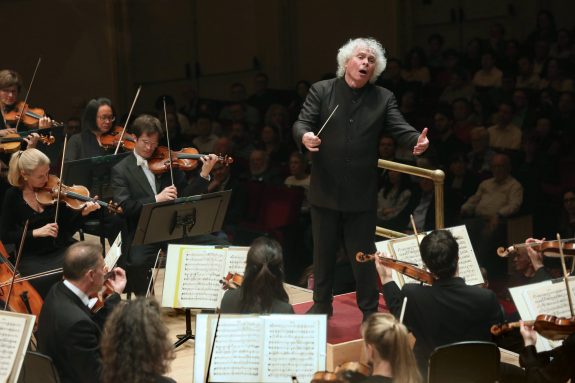 United States [1] Hindemith, Zemlinsky, Mahler: Lester Lynch (baritone), Bavarian Radio Symphony Orchestra / Sir Simon Rattle (conductor). Carnegie Hall, New York, 2.5.2024. (ES-S)
United States [1] Hindemith, Zemlinsky, Mahler: Lester Lynch (baritone), Bavarian Radio Symphony Orchestra / Sir Simon Rattle (conductor). Carnegie Hall, New York, 2.5.2024. (ES-S)

Hindemith – Ragtime (Well-Tempered)
Zemlinsky – Symphonische Gesänge, Op.20
Mahler – Symphony No.6 in A minor
[2] Wagner, Adès, Beethoven: Bavarian Radio Symphony Orchestra / Sir Simon Rattle (conductor), Carnegie Hall, New York, 3.5.2024.
Wagner – Prelude and Liebestod from Tristan und Isolde
Adès – Aquifer
Beethoven – Symphony No.6 in F major, Op.68, ‘Pastoral’
Since his Carnegie Hall debut at 21, made while helming the London Schools Symphony Orchestra, Sir Simon Rattle has been a steady presence in New York as principal conductor of the Berlin Philharmonic. After a briefer stint than many expected as music director of the London Symphony Orchestra, he has now returned to Germany as chief conductor of the Bavarian Radio Symphony Orchestra (BRSO). The two Carnegie Hall performances in early May are part of their first US tour together.
Since we are in full swing at Carnegie Hall in a festival entitled ‘Fall of the Weimar Republic: Dancing on the Precipice’, it was more than appropriate for Rattle and his ensemble to start with two representative works, even if little known, composed in the 1920s.
Paul Hindemith’s Ragtime (Well-tempered) embodies the witty, eclectic and irreverent spirit of the era, which was also expressed in the works of Francis Picabia and the Dadaists. In this brief piece, Hindemith ingeniously parodied the theme of Johann Sebastian Bach’s C-minor fugue in Book I of The Well-Tempered Clavier, transforming it into a lively rag enriched with dissonant harmonies. The performance was an enjoyable moment for both the interpreters and the audience.
Composed by Alexander Zemlinsky in 1929, Symphonische Gesänge is a cycle of seven songs set to German translations of poems by African American writers – Langston Hughes, Countee Cullen, Frank Smith Horne – associated with the Harlem Renaissance. It is the first time that the cycle has been performed in its entirety at Carnegie Hall. Diverging from Zemlinsky’s earlier compositions which are steeped in Mahler’s late Romanticism or Schoenberg’s modernism, the music of Symphonische Gesänge demonstrates a notable sense of restraint. From melancholy winds to clattering percussion, its evocative power of suggestion was truly remarkable.
Baritone Lester Lynch, the evening’s soloist, delivered a performance of emotional resonance with a commanding stage presence, infusing the songs with great gravitas. His rendition illuminated the cycle’s rich tapestry of drama, irony, defiance and hope, and his insightful notes in Playbill added an extra layer of appreciation for the audience.
Co-commissioned by Carnegie Hall and receiving its US premiere on this occasion, Thomas Adès’s Aquifer stood out as the only piece in either BRSO performance that was conceived outside German-speaking lands. In this work in seven sections, meant to celebrate Sir Simon Rattle’s inaugural season at the helm of the BRSO, the fecund and prolix Adès proved again his gift for outstanding orchestral colors. The repetitive, obsessive music could alternately sound like a multitude of individual voices in prayer trying to find a communal expression, or like the heavy, disturbing, menacing breathing of Fafner in his cave. Rattle handled the massive waves of ascending and receding sounds with impressive precision, and the climactic coda was breathtaking.
Wagner’s Prelude and Liebestod from Tristan and Isolde were ‘painted’ with similarly large brushstrokes. The tremendous swelling of the strings was permeated by gorgeously drawn lines from the woodwinds and harp, and the inescapable descent into the abyss in the Liebestod was imbued with carefully measured pathos.

Programming two monumental symphonies conceived a century apart – Beethoven’s ‘Pastoral’ and Mahler’s Sixth – underscored common traits and the extensive influence of Beethoven. It seems likely that Mahler reflected on Beethoven’s symphonic legacy while composing his own Sixth Symphony. Although Mahler’s work incorporates folk-inspired rhythms and melodies and revisits thematic material, as Beethoven did in the ‘Pastoral’, these elements serve profoundly different artistic and emotional purposes. Most notably, Mahler’s ‘Tragic’ Symphony diverges significantly in its darker and more complex portrayal, moving away from the idyllic and literal interpretations of nature found in Beethoven’s ‘Pastoral’. It is a contrast highlighting the evolution of symphonic music from Beethoven to Mahler and illustrating a shift from scenic depiction to deep existential exploration.
Both symphonies are dear to Rattle, and he conducts them frequently, infusing each performance with a sense of urgency. While he allows the music to flow unimpeded, his meticulous attention to detail remains evident. In the ‘Pastoral’, each section’s individual character was clearly delineated with strong dynamic contrasts. In the ‘Scene by the brook’, the music meandered in a relaxed manner. Conversely, the ‘Thunderstorm’ possessed a menacing quality that suggested more than just a natural occurrence.
The first movement of Mahler’s Symphony No.6, one of Rattle’s calling cards, was characterized by an unyielding forward momentum, affording little opportunity for the audience to breathe or savor the moments of beauty. In the Andante, the orchestra’s mellifluous strings beautifully carried forward the melodic line. To better prepare listeners for the tragic Allegro moderato, the conductor repositioned the darker Scherzo to immediately precede it. The buildup in the Finale was crafted in such a way that it consistently maintained hopes for a positive resolution, making the two inexorable hammer blows feel even more like a devastating denouement.
The Bavarian Radio Symphony Orchestra (Symphonieorchester des Bayerischen Rundfunks in German), which is celebrating its 75th anniversary this year, was ranked third among the world’s top-ten orchestras in 2023 by a panel of critics polled by Bachtrack. Their first performances together in New York, which included an encore – Dvořák’s Slavonic Dance No.7 – performed as a tribute to Rattle’s predecessor, the late Mariss Jansons, indicate that the BRSO-Rattle partnership is off to a strong start. One eagerly looks forward to seeing how it develops.
Edward Sava-Segal
